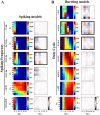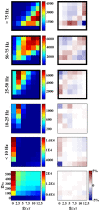Conductance ratios and cellular identity
- PMID: 20628472
- PMCID: PMC2895636
- DOI: 10.1371/journal.pcbi.1000838
Conductance ratios and cellular identity
Abstract
Recent experimental evidence suggests that coordinated expression of ion channels plays a role in constraining neuronal electrical activity. In particular, each neuronal cell type of the crustacean stomatogastric ganglion exhibits a unique set of positive linear correlations between ionic membrane conductances. These data suggest a causal relationship between expressed conductance correlations and features of cellular identity, namely electrical activity type. To test this idea, we used an existing database of conductance-based model neurons. We partitioned this database based on various measures of intrinsic activity, to approximate distinctions between biological cell types. We then tested individual conductance pairs for linear dependence to identify correlations. Contrary to experimental evidence, in which all conductance correlations are positive, 32% of correlations seen in this database were negative relationships. In addition, 80% of correlations seen here involved at least one calcium conductance, which have been difficult to measure experimentally. Similar to experimental results, each activity type investigated had a unique combination of correlated conductances. Finally, we found that populations of models that conform to a specific conductance correlation have a higher likelihood of exhibiting a particular feature of electrical activity. We conclude that regulating conductance ratios can support proper electrical activity of a wide range of cell types, particularly when the identity of the cell is well-defined by one or two features of its activity. Furthermore, we predict that previously unseen negative correlations and correlations involving calcium conductances are biologically plausible.
Conflict of interest statement
The authors have declared that no competing interests exist.
Figures









References
-
- Harris-Warrick RM, Marder E, Selverston AI, Moulins M, editors. Dynamic Biological Networks: The Stomatogastric Nervous System. Cambridge, Massachusetts: The MIT Press; 1992. 328
-
- Prinz AA, Bucher D, Marder E. Similar network activity from disparate circuit parameters. Nat Neurosci. 2004;7:1345–1352. - PubMed
-
- Schulz DJ, Goaillard JM, Marder E. Variable channel expression in identified single and electrically coupled neurons in different animals. Nat Neurosci. 2006;9:356–362. - PubMed
-
- Marder E, Thirumalai V. Cellular, synaptic and network effects of neuromodulation. Neural Netw. 2002;15:479–493. - PubMed
-
- Marder E, Prinz AA. Modeling stability in neuron and network function: the role of activity in homeostasis. Bioessays. 2002;24:1145–1154. - PubMed
Publication types
MeSH terms
Substances
Grants and funding
LinkOut - more resources
Full Text Sources

